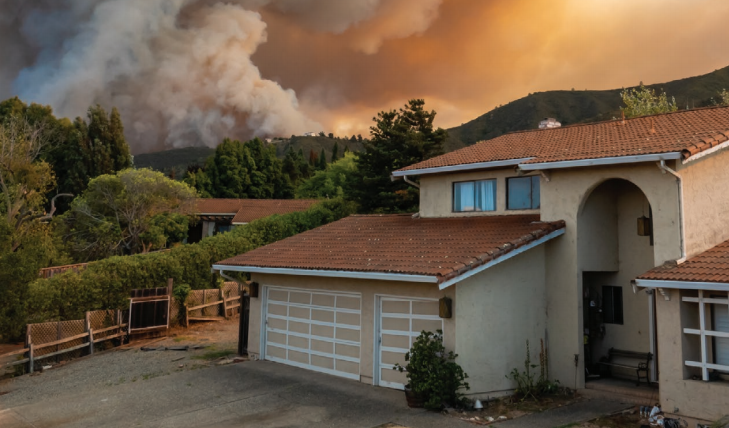Nearly Doubling a Property’s Wildfire Survival Rate: New Study from Zesty.ai in Collaboration with the Insurance Institute for Business & Home Safety Shows Impact of Key Mitigation Action


Oakland, Calif., April 8, 2021: Zesty.ai, a leader in climate risk analytics powered by Artificial Intelligence (AI), and the Insurance Institute for Business & Home Safety (IBHS) today released new research on how fuel management impacts destruction rates from wildfires. They found property owners who clear vegetation from the perimeter of their home or building can nearly double their structure’s likelihood of surviving a wildfire.
Zesty.ai, in conjunction with, IBHS studied more than 71,000 properties involved in wildfires between 2016 and 2019 to assess the relationship between vegetation, buildings, and property vulnerability. To do this, Zesty.ai leveraged a combination of computer vision and AI to analyze high resolution satellite and aerial imagery of the properties that fell within the wildfire perimeter, which allowed them to determine what effects a property’s physical environment had on its likelihood of survival. They found buildings with a high amount of vegetation within 5 feet of the structure were destroyed in a wildfire 78 percent of the time — a rate nearly twice as high as those with small amounts of perimeter vegetation. This pattern held true as Zesty.ai analyzed the other defensible zones, ranging from 30 to 100 feet around the property.
“It’s common sense that increased vegetation increases wildfire risk, but this study shows just how powerful individual action can be in safeguarding structures. Mitigation actions that can cut risk nearly in half are statistically meaningful to anyone with a stake in this peril,” said Attila Toth, CEO of Zesty.ai. “These findings also underscore how wildfire research at IBHS and artificial intelligence at Zesty.ai translates to real-world impact at the intersection of homeowners, community leaders, regulators, and insurance carriers. This type of collective action will help protect our communities from the devastating impact of wildfire, which unfortunately has continued to increase over the last several decades.”
The study also supported and confirmed takeaways from IBHS’s Suburban Wildfire Adaptation Roadmaps released last year, which go beyond the home ignition zone to detail additional actions needed across eight aspects of a home to address a home’s wildfire vulnerability. Zesty.ai’s new research found that having other structures in close proximity to a property increases its wildfire risk, particularly for properties in areas with moderate to high vegetation coverage. Buildings in these areas that had another structure within 30 to 100 feet from the property were destroyed in a wildfire 60 percent of the time, compared to a 31 percent destruction rate for homes without another structure in close proximity.
“This research further demonstrates to homeowners, community leaders, and policy makers just how impactful taking the mitigation actions laid out in the Suburban Wildfire Adaptation Roadmaps can be in protecting homes from wildfire ignition,” said Roy E. Wright, President & Chief Executive Officer at IBHS. “Quantifying the effect of mitigating fuel density risk, one of the critical actions identified in the Roadmaps, is a first piece in the larger puzzle of what groups of mitigation actions most improve the chance of home survival and by what level.”
Zesty.ai is uniquely equipped to support this type of research because of the proprietary wildfire property loss database it developed for Z-FIREᵀᴹ, its AI model that generates property-specific predictive risk scores. Z-FIRE has been trained on more than 1,200 wildfire events across several decades and accounts for the property-level factors that contribute to wildfire risk, including defensible space, building material, and roof pitch, which legacy models fail to consider.
Wright added, “While it is not possible to eliminate wildfire risk we are not powerless against it. We must take a pragmatic approach to mitigate risk at all levels and ultimately reduce property damage through data and science. Through collaborations with modelling organizations like Zesty.ai, advanced technology like computer vision and AI help us better understand the impact of these actions at a larger scale. It is encouraging to see emerging progress in just the first months of 2021.”
For additional insights you can read the full research paper, ‘Wildfire Fuel Management and Risk Mitigation – Where to Start?’ here. For more information on Zesty.ai please visit www.zesty.ai, and for more information on IBHS please visit www.ibhs.org.
Recent Posts
NOAA Weather
Tampa, FL
Last Updated on Jun 5 2024, 6:53 am EDT
Weather by NOAA
Current Conditions: Fair
Temp: 77°F
Wind: SE at 5mph
Humidity: 88%
Dewpoint: 73.0°F
 National Hurricane Center
National Hurricane Center
- The Atlantic hurricane season runs from June 1st through November 30th. April 20, 2025The Atlantic hurricane season runs from June 1st through November 30th.